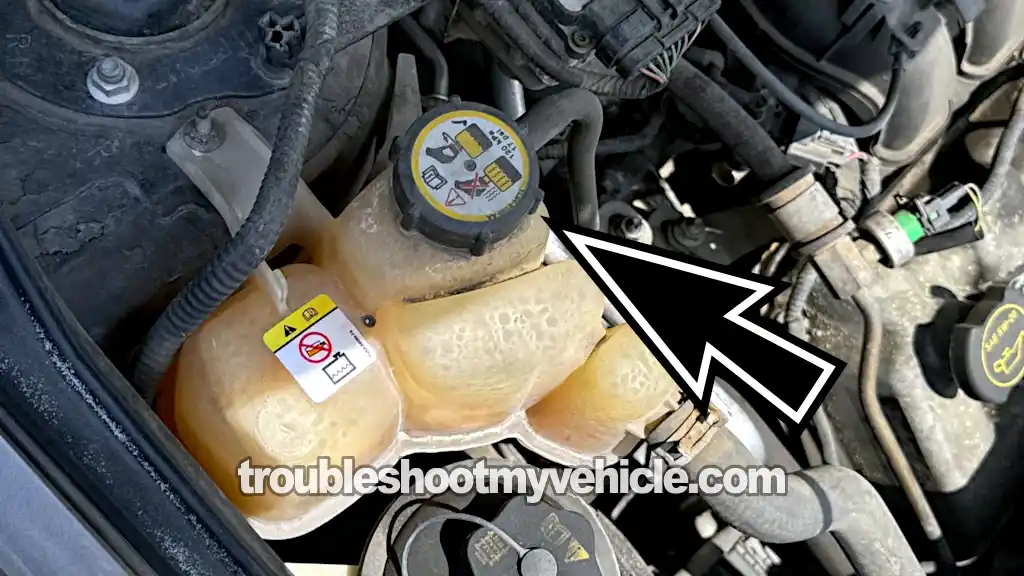
Your 3.0L V6 Ford Escape (Mazda Tribute) comes equipped with two head gaskets, and if you suspect you have a blown head gasket issue, I'm going to show you how to confirm it with one of four tests.
Two of these tests don't require any tools and can be done in under five minutes. The other two are a compression test, which requires a compression tester, and a block test done with a combustion leak detector.
Hopefully, you don't have a blown head gasket on your hands, but if you do, you'll be able to quickly and easily confirm it with one of these four tests.
Contents of this tutorial:
ES ![]() You can find this tutorial in Spanish here: Cómo Probar El Empaque De Cabeza (3.0L Ford Escape) (at: autotecnico-online.com).
You can find this tutorial in Spanish here: Cómo Probar El Empaque De Cabeza (3.0L Ford Escape) (at: autotecnico-online.com).
APPLIES TO: This tutorial applies to the following vehicles:
- 3.0L V6 Ford Escape: 2001, 2002, 2003, 2004, 2005, 2006, 2007, 2008, 2009, 2010, 2011, 2012.
- 3.0L V6 Mercury Mariner: 2005, 2006, 2007, 2008, 2009, 2010, 2011.
- 3.0L V6 Mazda Tribute: 2001, 2002, 2003, 2004, 2005, 2006.
Symptoms Of A Blown Head Gasket
Here's a basic list of what you may see if your 3.0L Escape (3.0 Tribute) has a blown head gasket:
- Your Escape is gonna' overheat.
- The engine oil will get mixed with coolant. This will turn the engine oil the color of coffee with too much creamer.
- White smoke coming out of the tail-pipe.
- Engine cranks, but does not start.
- No compression on two adjacent cylinders.
- Coolant being pushed forcibly into the coolant reservoir bottle whenever the engine idles or the engine is turned off.
If your 3.0L Ford Escape starts and runs, but overheats and you have already checked and confirmed that the water pump, the thermostat, the radiator fan motors are OK, then there's a good chance you have a blown head gasket on your hands. The following 4 tests will help find out.
TEST 1: Engine Oil Mixed With Coolant

The most common end result of having one or both head gaskets fail on your 3.0L V6 Ford Escape is coolant entering the crankcase and turning the engine oil into something that looks like coffee with too much creamer.
As a matter of fact, the very first test that an automotive tech or mechanic will usually perform to check for a blown head gasket is to look at the color of the engine oil on the dipstick.
To kick off our blown head gasket diagnostic, we're going to do exactly that —pull the engine oil dipstick out and see what the oil looks like.
Let's get going:
- 1
Open the hood of the Ford Escape.
- 2
Pull out the engine oil dipstick.
- 3
Check the color of the oil sticking to the dipstick.
- 4
You'll see one of two things:
1.) The color of the oil will be a milky white color (like coffee with too much cream).
2.) The color of the oil will be its normal color.
Let's take a look at what your test results mean:
CASE 1: The engine oil was a milky white color. This tells you that the coolant is mixing with the engine oil as a result of a blown head gasket.
CASE 2: The engine oil was its normal color. So far so good. You're not out of the woods yet, your next step is to see if the head gasket is leaking cylinder compression pressure into the cooling system.
For this test go to: TEST 2: Coolant Shooting Out Of The Coolant Expansion Tank.
TEST 2: Coolant Shooting Out Of The Coolant Expansion Tank

The second most common problem that a blown head gasket causes is combustion pressures and gases escaping into the engine's cooling system, which will cause the cooling system of your Ford Escape to over-pressurize.
We can easily check if this has happened by removing the cap from the coolant reservoir/expansion tank and then cranking the engine to see what the coolant inside the tank does.
If one or both of the head gaskets have failed, then you're going to see the coolant inside the tank being forcefully shot out, which will confirm the issue.
The correct and expected test result is for the coolant inside the expansion tank to remain undisturbed no matter how long we crank the engine.
OK, these are the test steps:
- 1
Remove the cap from the coolant reservoir/expansion tank.
IMPORTANT: The engine should be completely cold before you open the coolant reservoir/expansion tank cap. Opening the coolant reservoir/expansion tank cap on a hot engine can spray hot coolant all over you and severely burn you. - 2
If the coolant level is low, top it off before proceeding.
- 3
Stand at a safe distance from the engine but within view of the coolant reservoir/expansion tank.
- 4
When ready, have your helper crank the engine.
You'll see one of two results: The coolant shoots out violently when the engine was cranked -OR- the coolant was not disturbed at all.
Let's take a look at what your test results mean:
CASE 1: The coolant shot out of the coolant reservoir/expansion tank. This confirms beyond a shadow of a doubt that you do have a blown head gasket on your hands.
CASE 2: The coolant DID NOT shoot out of the coolant reservoir/expansion tank. So far so good. Your next test depends on one of two things:
- The engine starts and runs, but overheats within minutes —Your next step is to do a block test with a combustion leak detector. Head over to: TEST 4: Using A Block Tester (Combustion Leak Tester).
- The engine starts and runs, but runs with a cylinder misfire —Your next step is to do an engine compression test. Go to: TEST 3: Engine Compression Test.
TEST 3: Engine Compression Test

In some cases, one of the two head gaskets gets burned in the spot right between two side-by-side cylinders. This causes the compression of one cylinder to escape into the other and vice-versa.
The end result of this condition is that the engine runs, but runs with a misfire (since those two cylinders are producing 0 PSI compression). The way to check this is by doing a compression test.
Now, doing a compression test on the Ford Escape's 3.0L V6 engine is not for the faint of heart, since the upper manifold plenum has to be removed. So, if one of the previous two tests has already confirmed a blown head gasket, you can skip this test.
NOTE: You can find how to do the compression test and how to interpret its results explained in more detail in this tutorial: How To Test Engine Compression (2001-2007 3.0L V6 Ford Escape).
These are the test steps:
- 1
Remove the ignition coils.
NOTE: This will require that you remove the upper intake manifold plenum and may have to consult a repair manual for the specifics of this procedure. - 2
Remove the spark plugs.
- 3
Install the compression tester (hand tight only) on the first cylinder you're gonna' test.
- 4
Have a helper crank the engine while you observe the compression tester.
- 5
When the needle stops moving, have your helper stop cranking the engine.
- 6
Write down the compression readings.
- 7
Remove the compression tester and repeat on the next 5 cylinders.
Let's take a look at what your test results mean:
CASE 1: You got 2 side by side (adjacent) cylinders with 0 PSI. This confirms beyond a shadow of a doubt that your Ford Escape does have a blown head gasket problem.
CASE 2: All cylinders had sufficient compression. This is the correct and expected test result and tells you that both head gaskets are not blown between any 2 adjacent cylinders.
If you still suspect that your Ford Escapes V6 engine has a blown head gasket, your next step is to do a block test. Head over to: TEST 4: Using A Block Tester (Combustion Leak Tester).
TEST 4: Using A Block Tester (Combustion Leak Tester)

Over the years, I've seen many cases where the vehicle had a blown head gasket issue but wasn't presenting any of the classic symptoms of such a problem.
For example, the oil wasn't mixed with coolant (TEST 1), combustion gas pressures weren't being shot out of the cooling system (TEST 2), and cylinder compression was fine (TEST 3).
What helped me nail down the problem and confirm that it was being caused by a head gasket failure was doing a block test with a combustion leak detector.
So, if in your case you've done the previous tests and they all pass with flying colors, but you still suspect you've got a failed head gasket on your hands, this is the next thing you need to do.
This is what the block test involves:
- A blue liquid chemical, which is blue in color, is placed in the tester (see photo above).
- The tester assembly is then placed on the open radiator neck (you may have to drain some of the coolant in the radiator since this tool needs to 'gulp' some of the air inside the radiator).
- The engine is started.
- The rubber bellow is then squeezed to suck in the air up through the two fluid-filled chambers. As the air bubbles up through the fluid, it will cause a chemical reaction.
- If the blue chemical turns yellow (for gasoline engines), combustion gases are entering the radiator. This result confirms a head gasket failure, a cracked block, or a cracked cylinder head issue.
- If the blue chemical doesn't change color, you can conclude that you don't have a head gasket failure, a cracked block, or a cracked cylinder head issue.
You can shop for a block tester here:
Disclosure: As an Amazon Associate, I earn from qualifying purchases. If my tutorials help you, using these links is an easy way to support the site at no extra cost to you. Thank you!
Frequently Asked Questions
1.) How can I tell if the cylinder head is cracked?
The cylinder head has to be removed and visually inspected. If the crack is wide enough, you'll be able to easily see it.
Sometimes, a visual inspection proves inconclusive, this is why it's important to let a machine shop pressure test it for you.
2.) Do I need to resurface the cylinder head?
YES, you need to resurface the cylinder head! You should never reinstall the cylinder head or cylinder heads without first having a Machine Shop resurface the cylinders heads (particularly over an overheating condition).
Now, of course, if you (or the machine) have checked it with a straight-edge and there's no warpage, then and only then is the cylinder head not resurfaced.
3.) Do I need to replace both cylinder head gaskets?
YES, you need remove both cylinders heads and replace both gaskets. You'll need to have both cylinders heads checked for cracks and resurfaced.
More 3.0L V6 Ford Escape Diagnostic Tutorials
You can find a complete list of diagnostics tutorials for the 3.0L V6 Ford Escape, Mercury Mariner, and Mazda Tribute in this index:
Here's a small sample of the tutorials you'll find:
- How To Test The Fuel Injectors (2001-2004 3.0L Ford Escape).
- How To Test For A Blown Head Gasket (3.0L V6 Ford Escape, Mercury Mariner).
- How To Test The Fuel Pump (2001-2004 3.0L Ford Escape).
- Bank 1 Sensor 1 Oxygen Sensor Heater Test -P0135 (2001-2004 3.0L Ford Escape).

If this info saved the day, buy me a beer!





